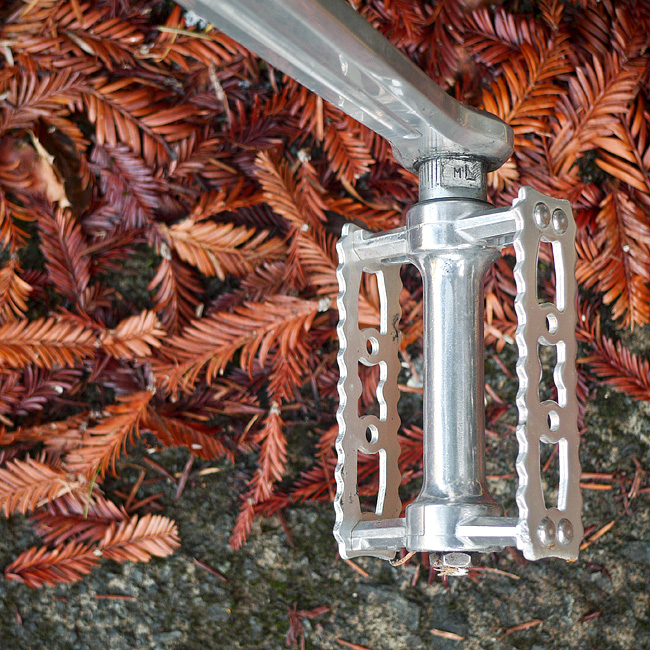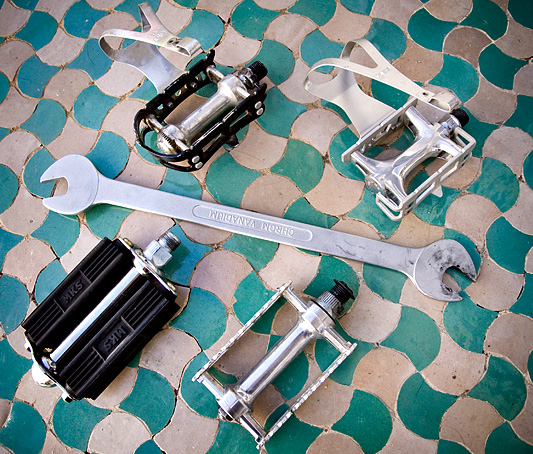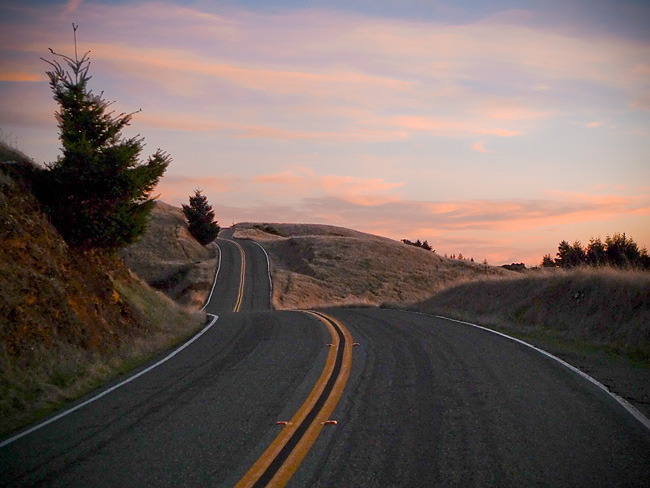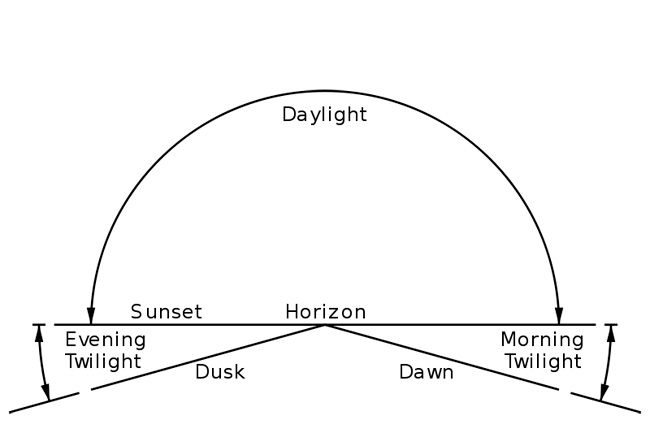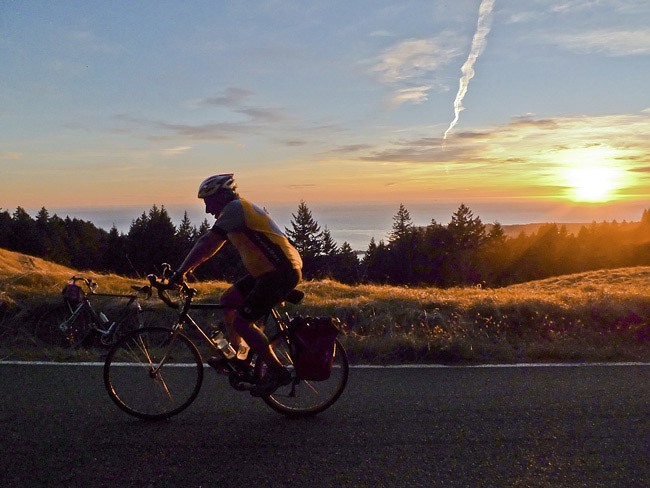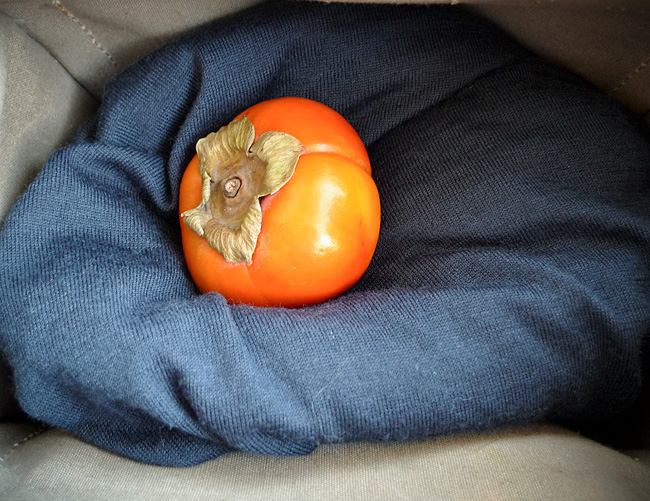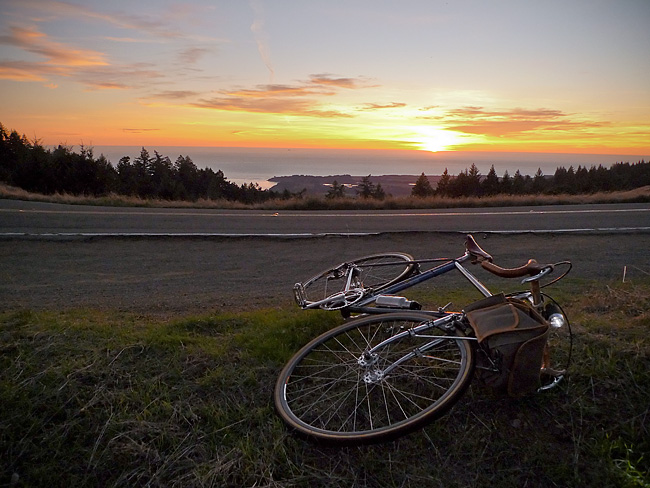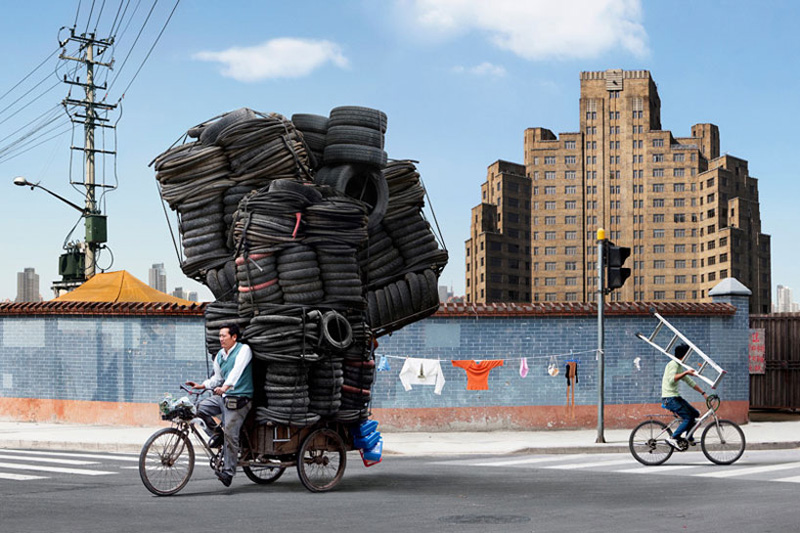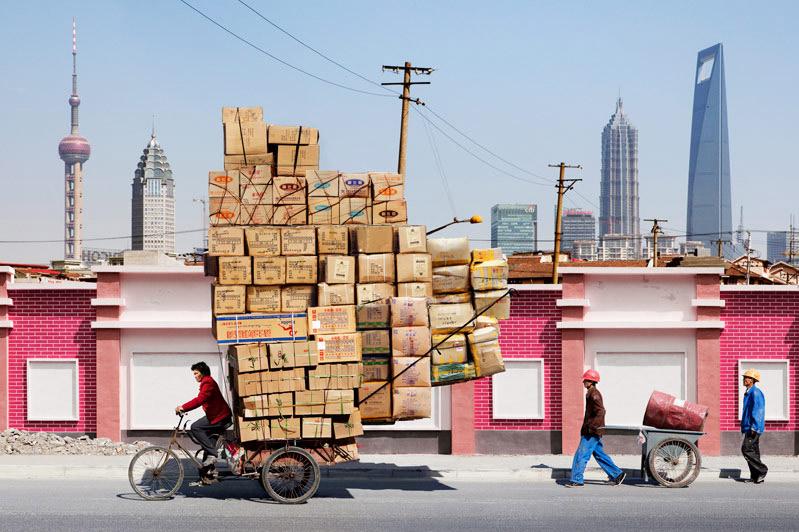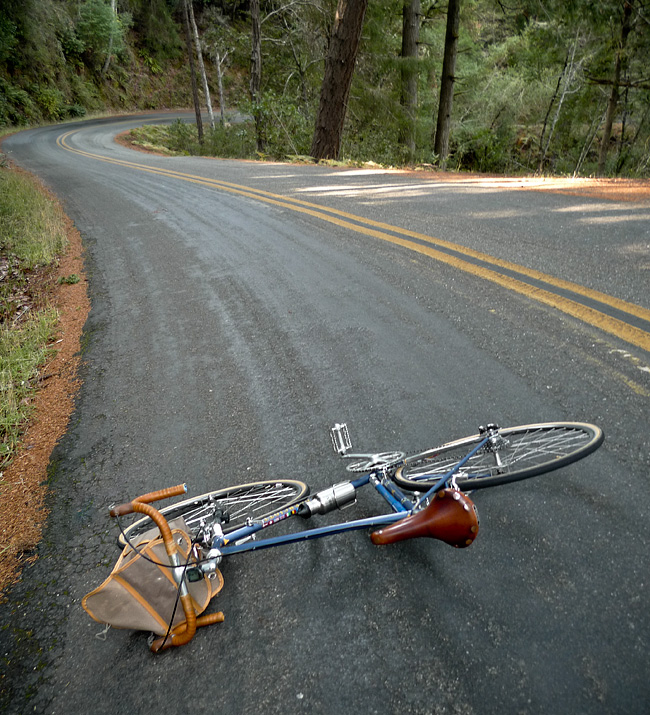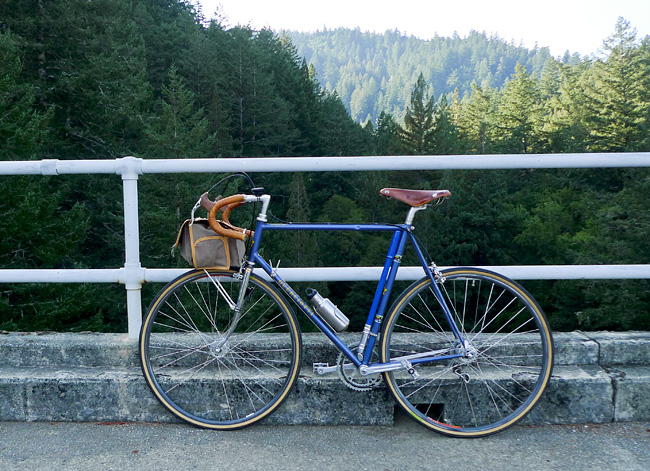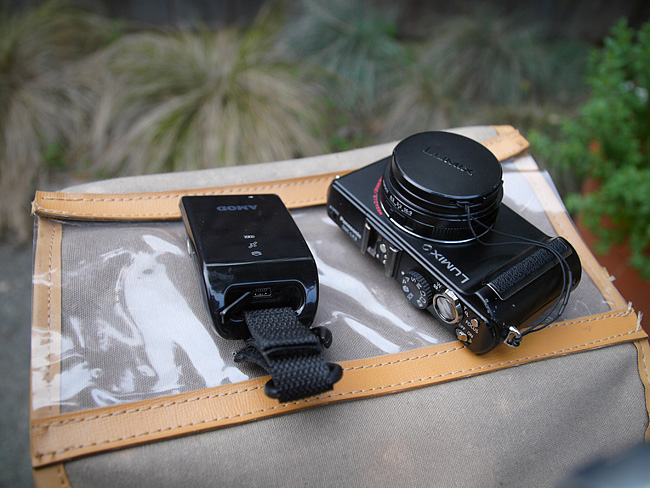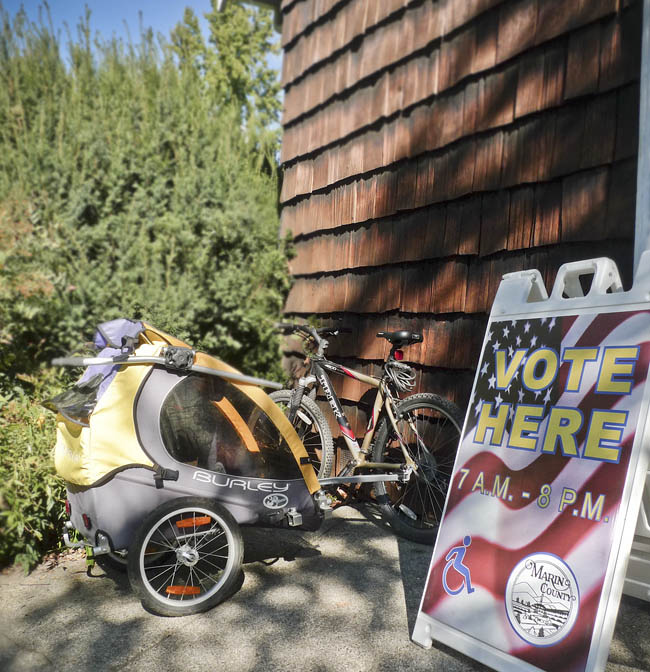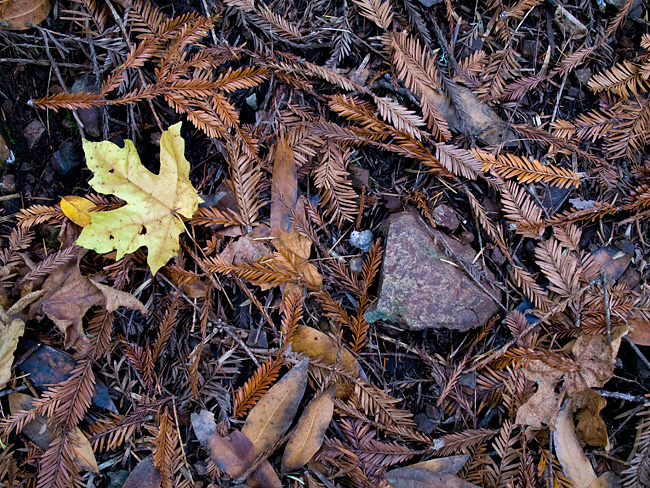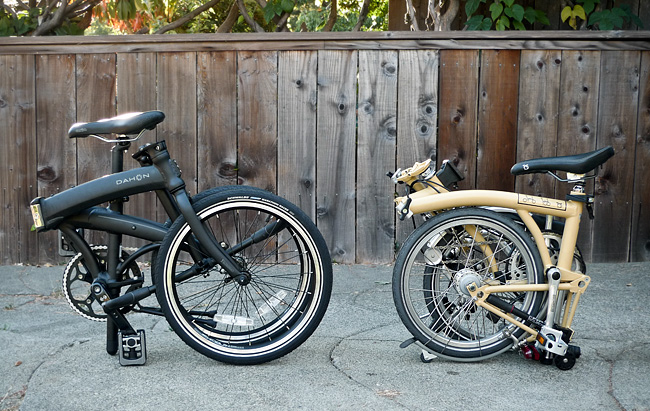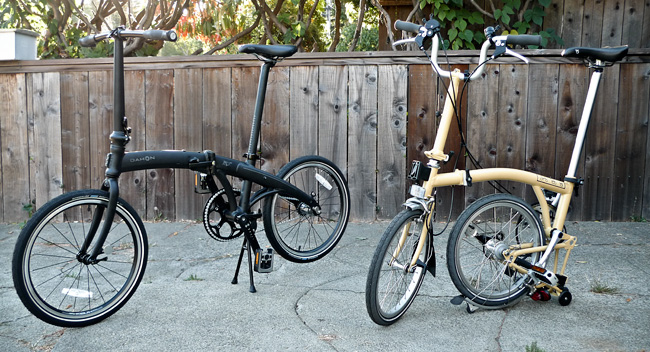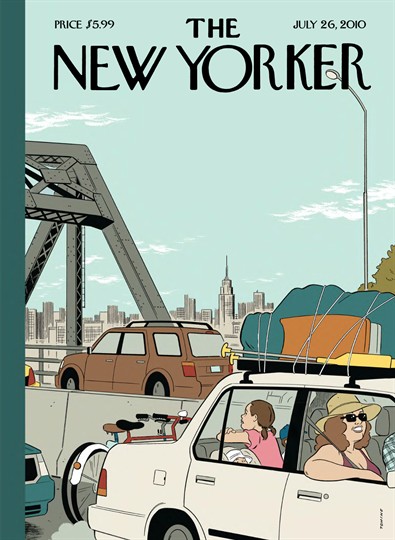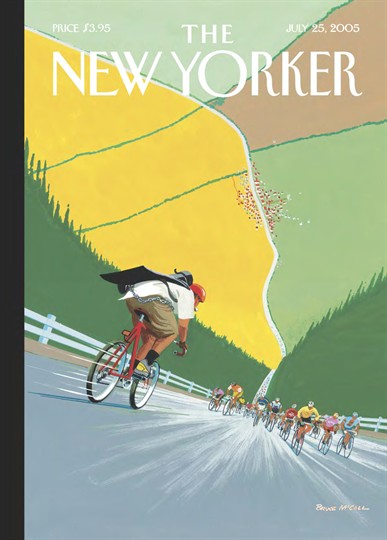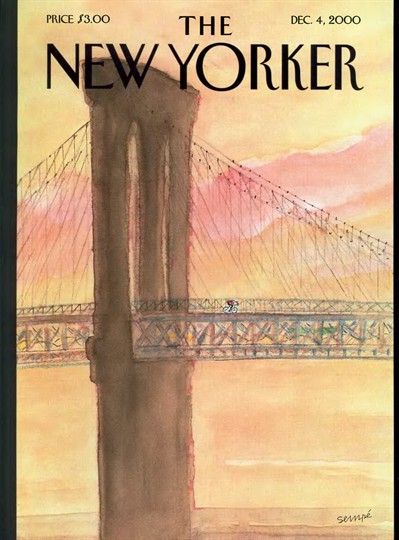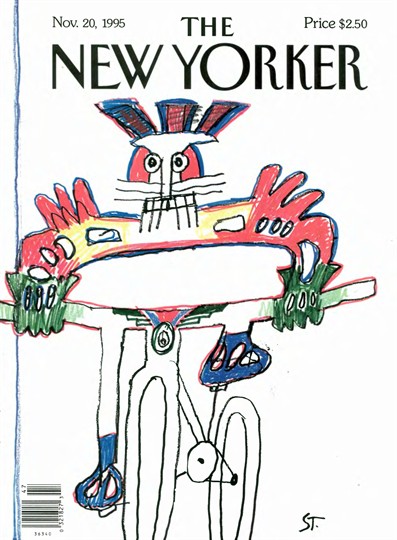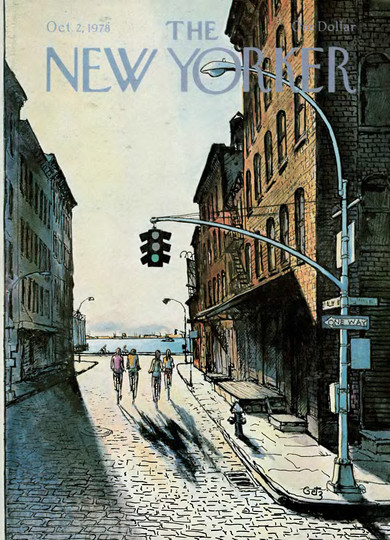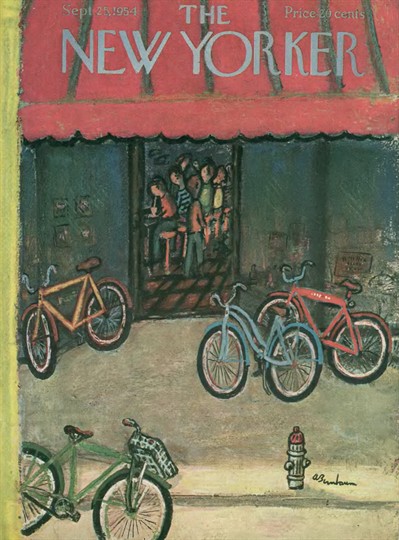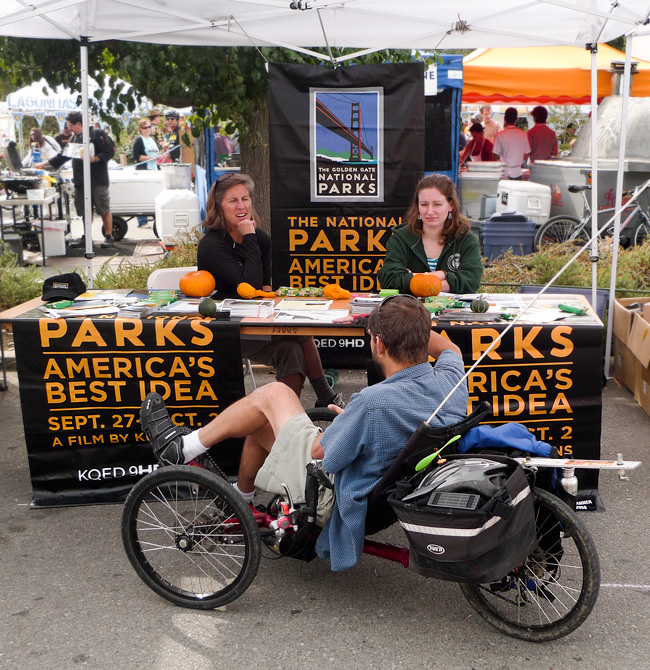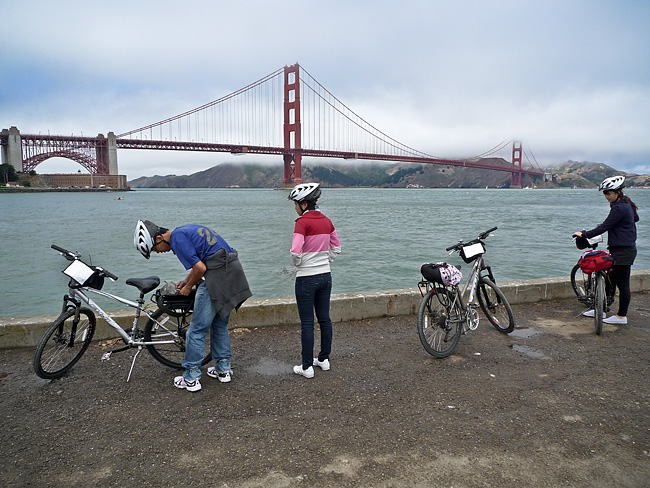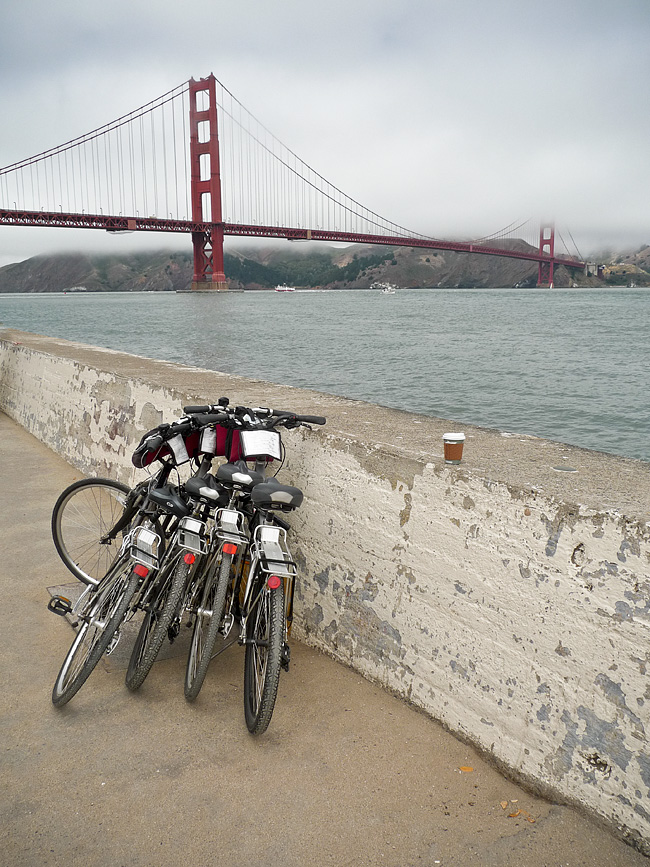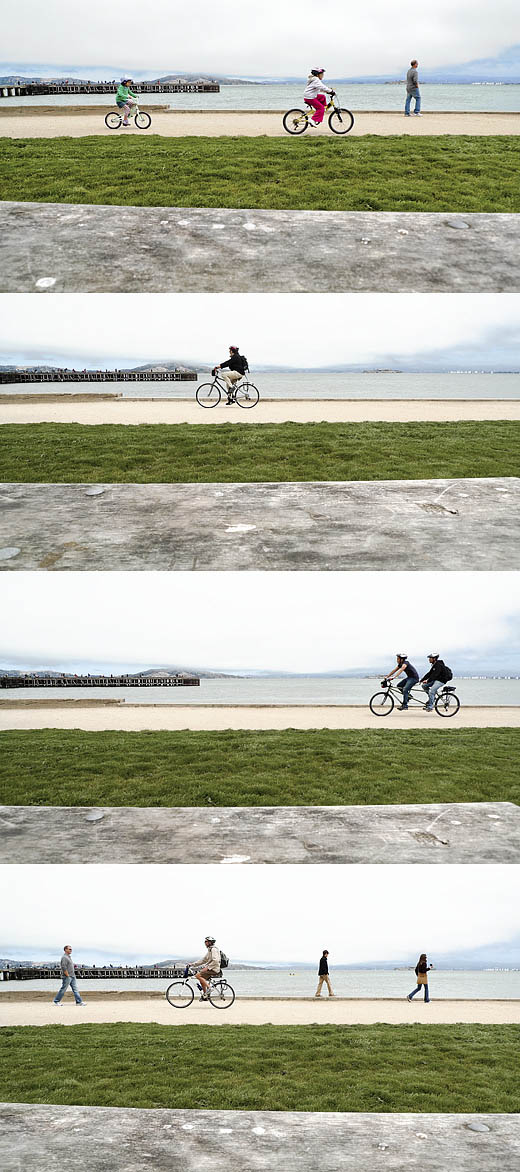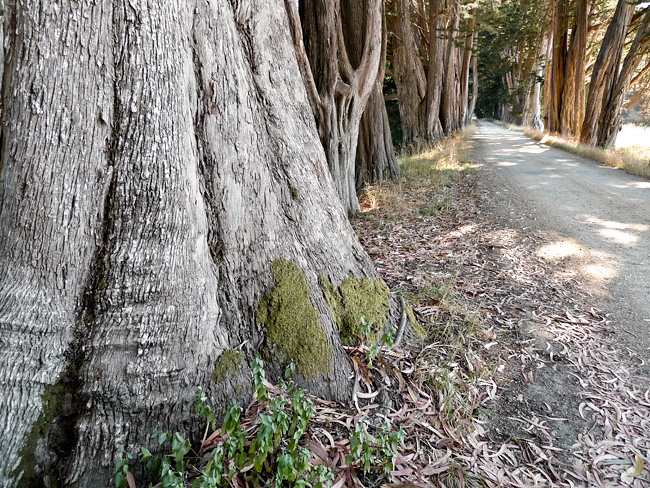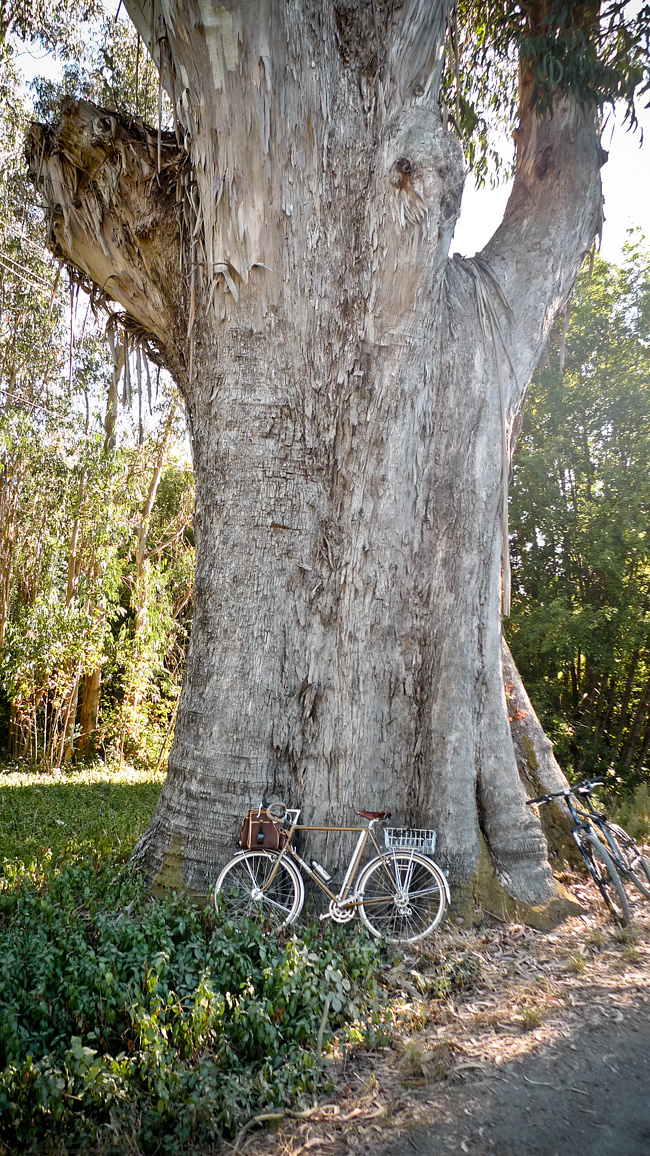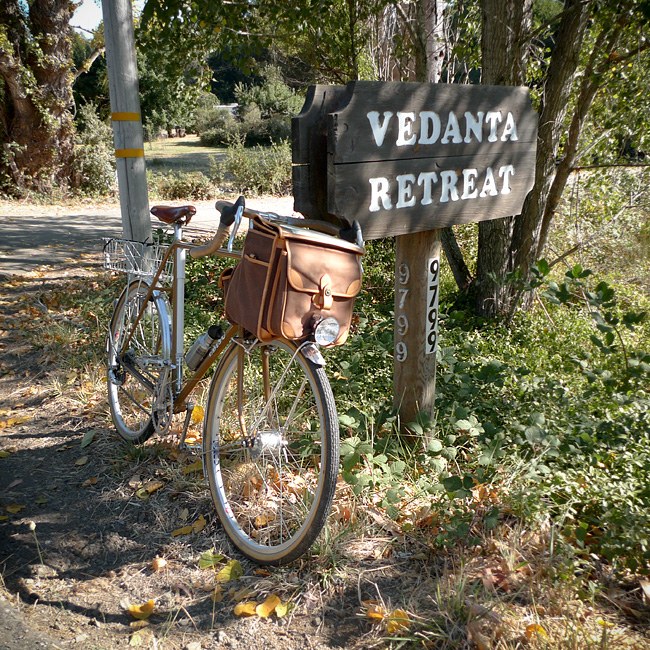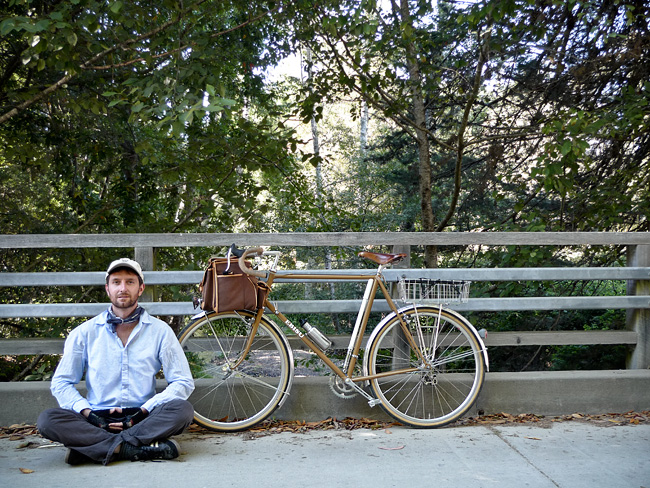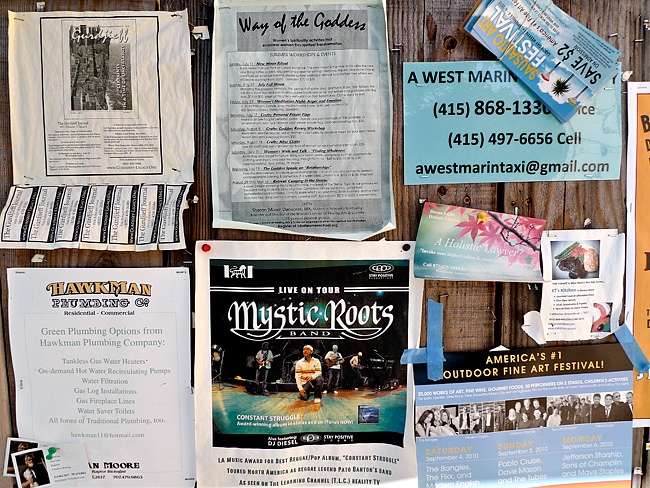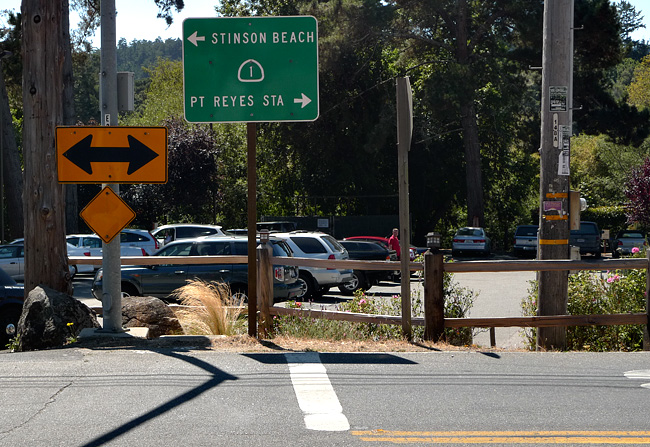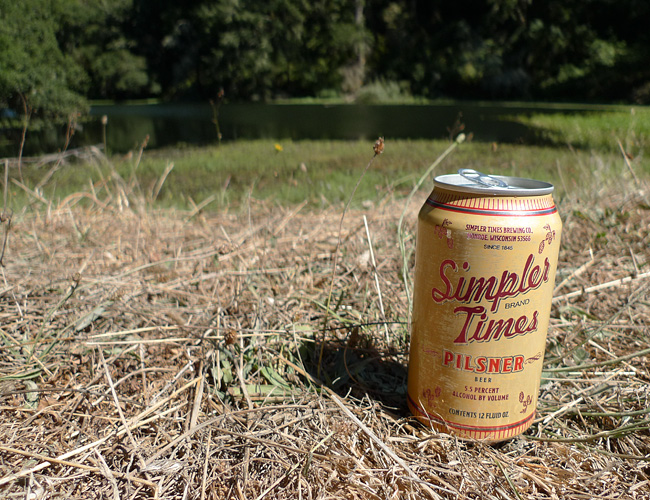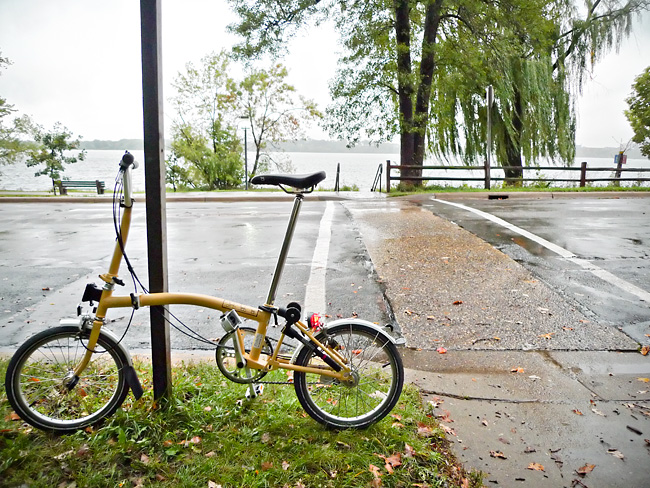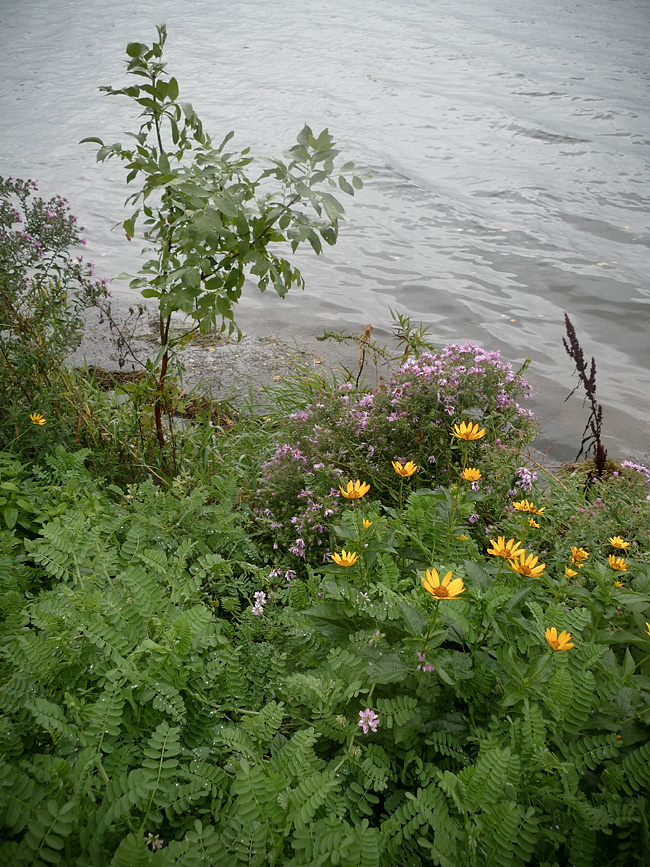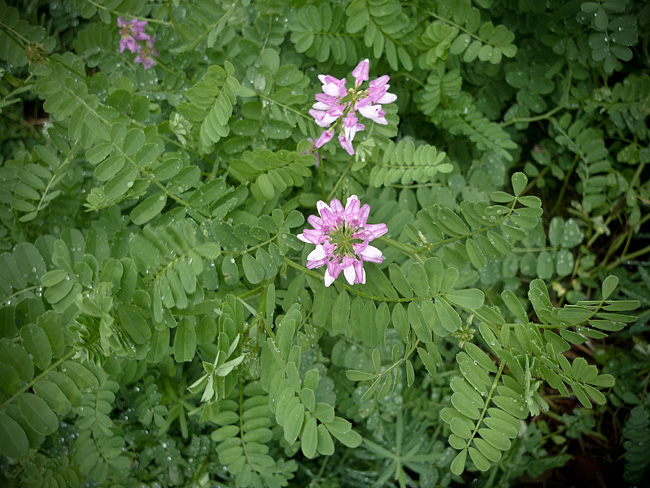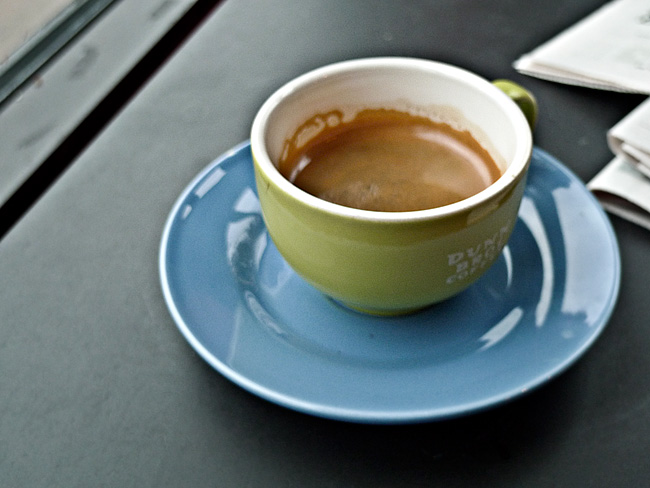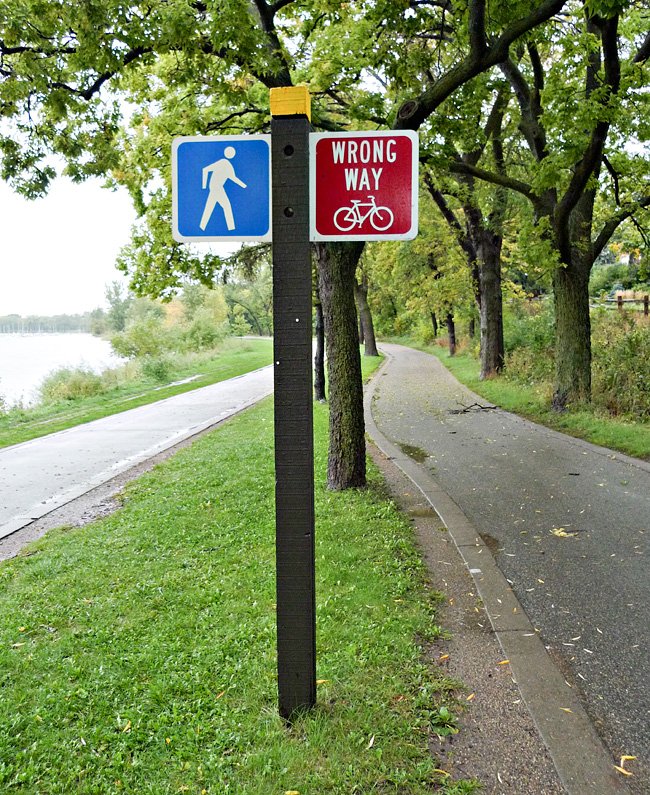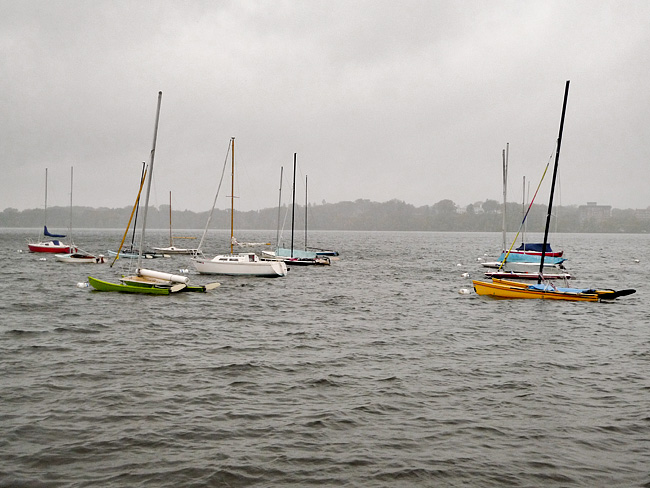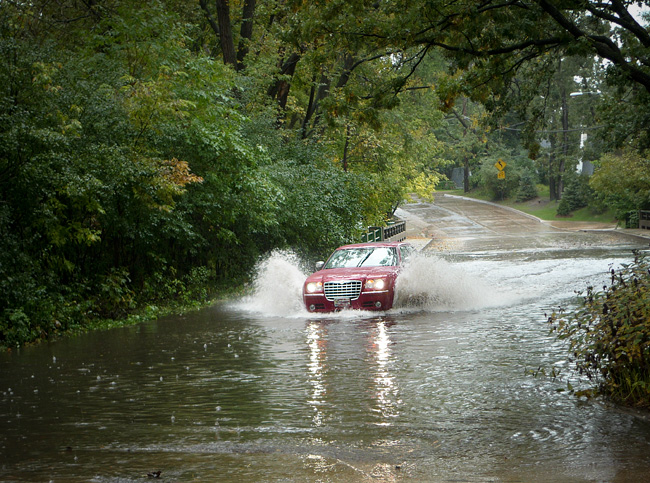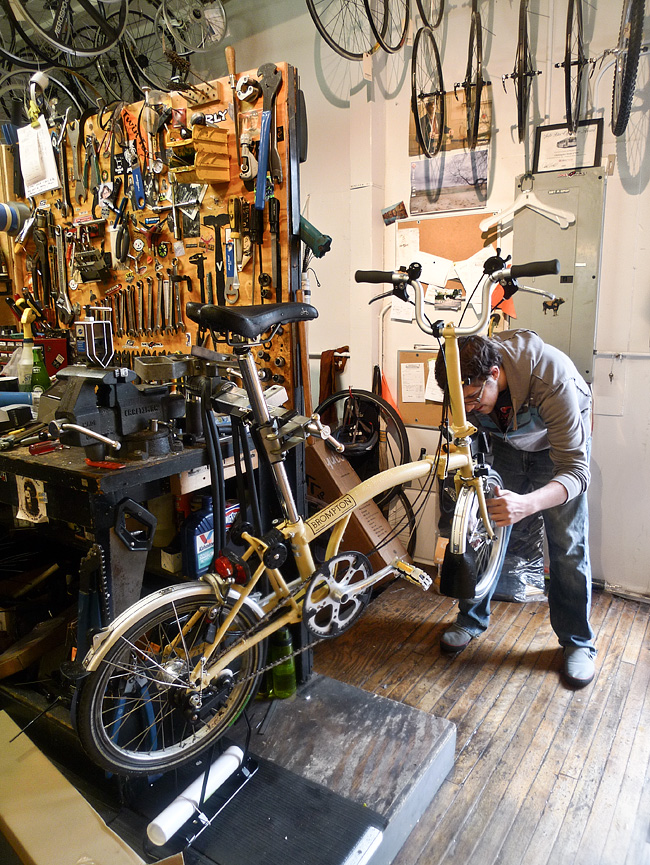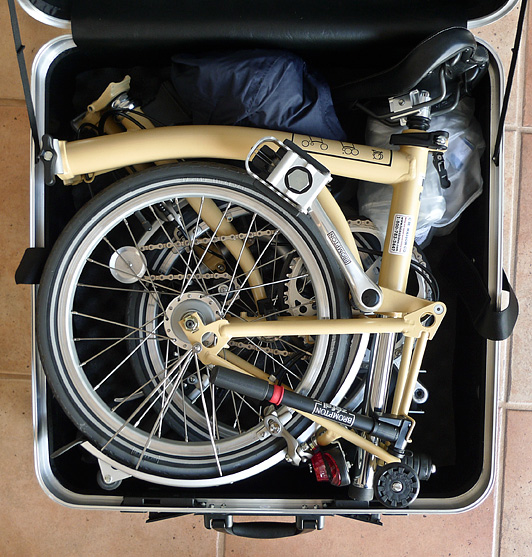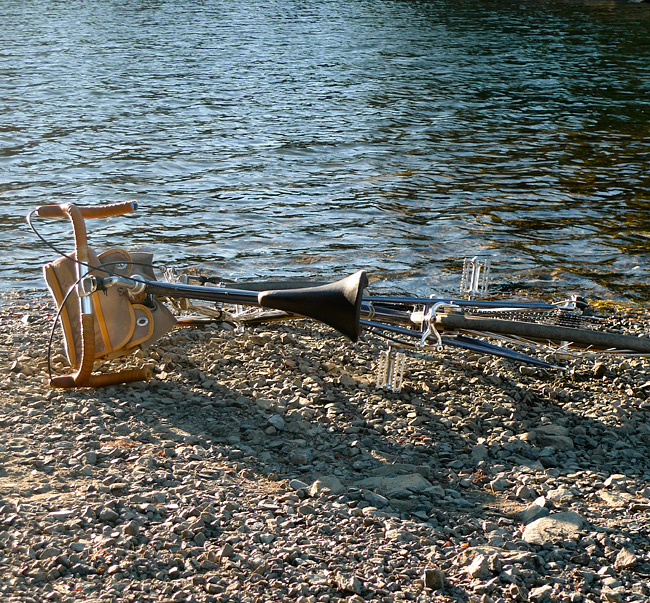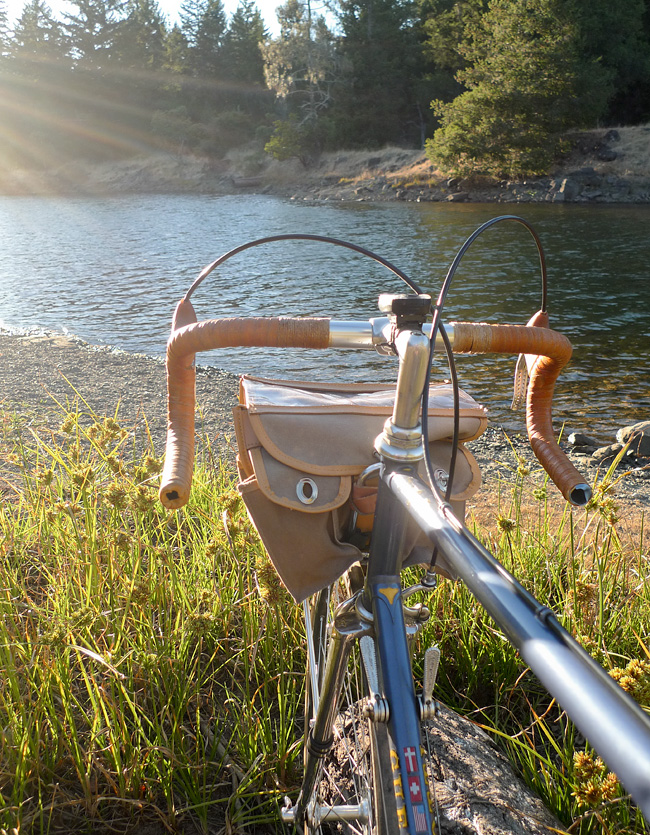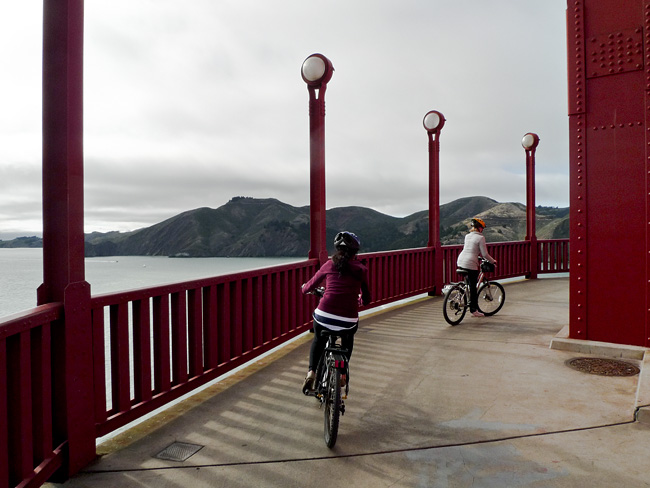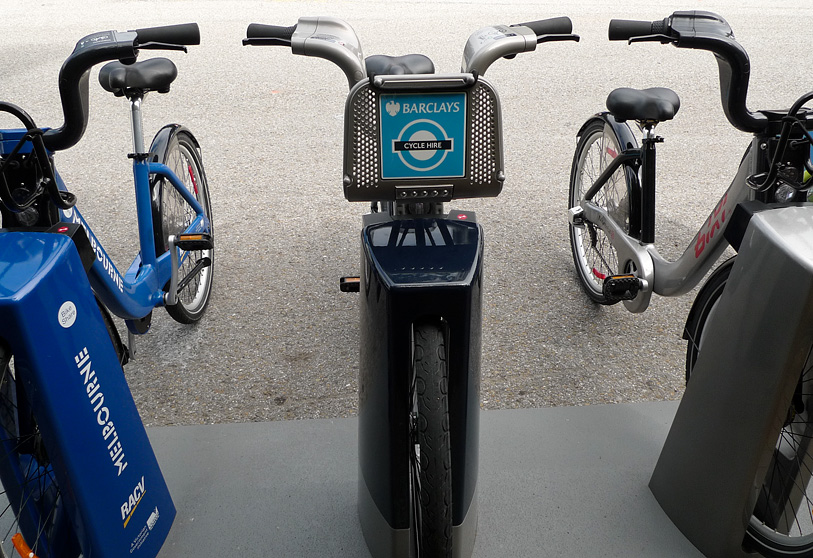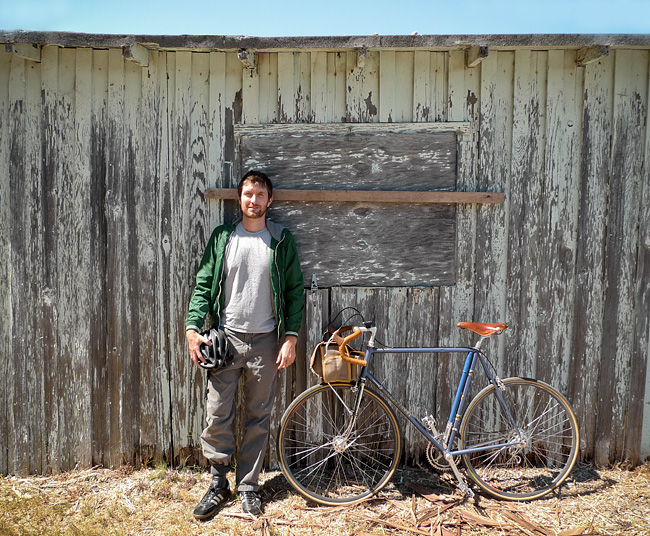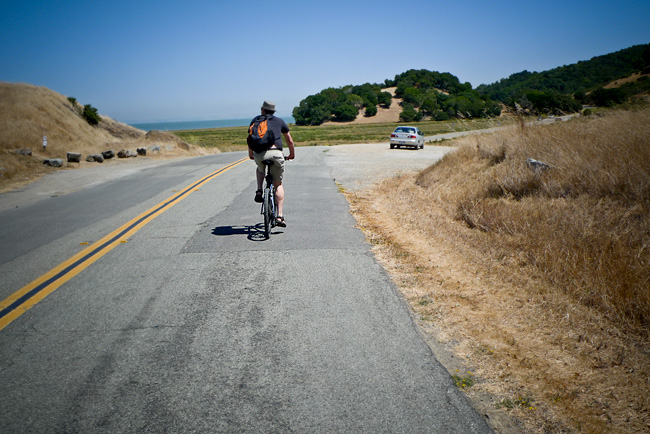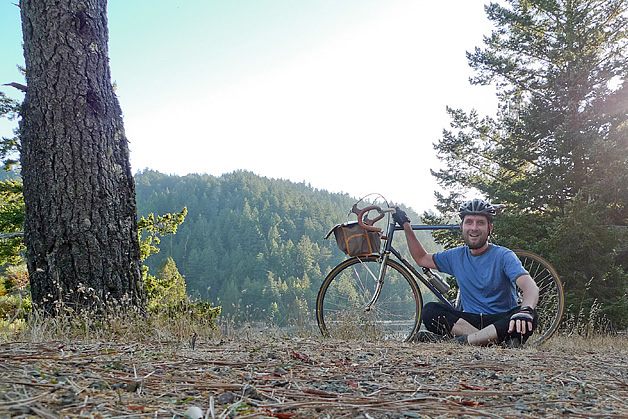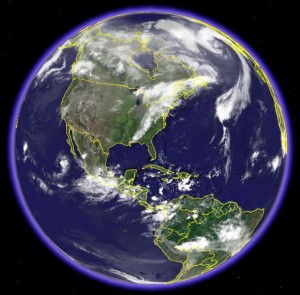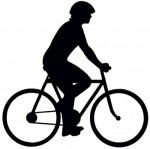On the Road……Fort Mason, San Francisco
I’ve recently begun some volunteer photography for the National Park Service in the GGNRA and therefore have been spending time around Fort Mason.
I’ve fallen in love with some of the trees scattered around this historic military base. I will post a few pictures soon.
Meantime, here’s a picture of a cyclist cutting through Fort Mason, probably on her way toward the Marina neighborhood.
Note: that’s a Metlife blimp slipping behind the chapel’s bell tower in the image above.
Gear Gallery……Pedals for all Occasions
I still prefer toe-clips and leather straps for long, somewhat fast rides, but these MKS touring pedals are my favorite choice for everything else. As a consequence, I end up swapping pedals from bike to bike.
Below are pedals currently in my mix (clockwise from top left): Campagnola (super record?); MKS royal noveau; MKS sylvan touring; and MKS 3000 rubber block pedals.
The rubber block pedals are a new purchase (for my Nishiki city bike). I went to 4-5 bike shops (including a local bicycle recyclery) and none had this simple design so I ordered them from the Velo-Orange store.
Also, the 13″ long wrench (an ELDI no. 61 available from Rivendell) is a worthwhile investment if you swap pedals frequently.
On the Road……Atop the Bolinas Ridge at Civil Twilight
This image from my recent ride along the Bolinas Ridge captures the specific time of the evening — civil twilight — when ambient light takes on a lovely bluish hue prized by painters and photographers.
Twilight, broadly speaking, refers to the time between sunset and dusk AND the time between sunrise and dawn (the chart below is a helpful tool for visualizing this).
But twilight (both morning and evening) is divided, more scientifically, into civil, nautical, and astronomical segments based upon the number of degrees the center of the sun is below the horizon (6, 6-to-12, and 12-to-18 degrees respectively).
Evening nautical twilight (nautical dusk) is said to end once sea navigation via the horizon line is no longer possible. Evening astronomical twilight (astronomical dusk) ends once the dimmest celestial objects (e.g. galaxies and nebulae) become properly visible to astronomical observation.
Commentary: in the context of the virtual world of Texting, Tweeting, and Tagging (from which I claim no exception) it feels palpably iconoclastic (if not downright subversive) to patiently witness our solar system’s sun disappearing ever so gently beyond the planet’s watery horizon.
Featured Comment by Shoeless Joe: “There is a biological connection, too, as the rods and cones in our eyes perceive light differently at twilight. It is called the Purkinje Shift (or Purkinje Effect). Wikipedia has a good article on it. One of the beauties of cycling is that it affords many opportunities to “patiently witness” the world around us in a way that is unique to the sport.”
Ride Report…A Late Fall Ride and a Pacific Ocean Sunset
I somehow got it into my mind that I needed to see the Pacific Ocean.
The solution was a 25 mile loop — from Fairfax up to and along Bolinas Ridge offering winding roads; steep climbs; fast descents; water and commanding Pacific Ocean views; relatively few cars; redwood forests; oak-studded grasslands; colorful autumn foliage; and, a smattering of wild life (I saw a coyote on top of the ridge and several deer on the way down).
In other words: there’s a bit of everything on this ride.
I departed around 3:30 pm (it’s getting dark by 5:30 pm) so I attached a headlight that I bought for my Brompton folding bike on the Guerciotti. I packed a persimmon and a wool turtleneck in my handlebar bag and wore a wool t-shirt and wool knickers. The weather, however, was unseasonably warm and I was comfortable for most of the ride in just the t-shirt. (Toward the end of the ride, I draped the sweater around my shoulders and tied the sleeves in a loose knot to keep it from slipping.)
I spent most of this ride chasing the sun. I’d catch it, then it would dip behind a ridge. This continued until I got to the final, long climb with the sun well hidden behind the ridge. But as I slowly pedaled up the road — and the 1000′ vertical feet of switch-backs — I realized that at the very top the sun would make a final appearance.
As the image shows, I caught the sun for the final time as I rode atop the ridge.
So what about the bicyclist in the picture?
I passed him about 6 miles earlier, but since I’m always on-and-off my bike making photographs he caught up with me (think of the tortoise and the hare). When I noticed him climbing up the ridge about 100 yards behind me I set-up for this photo.
As the tortoise passed me, I exclaimed, “That’s a beautiful picture!” The tortoise turned briefly toward the sunset and replied, “it’s not real”.
At first I thought he was referring to the almost hyper-real colors (you know how sometimes nature reveals scenes — especially cloud formations and sunsets — that would be unbelievable had you not witnessed them with your own eyes?).
But on further reflection, maybe he was referring to photography itself and the philosophically problematic nature of attempting to reproduce reality with a machine!
Anyhow, I lingered on the ridge for 10-15 minutes and watched the sun dip below the horizon. Mosquitoes bit my arms and legs. I devoured a persimmon then turned on my headlight and rode home.
On the Road……Persimmons: A Most Refreshing Snack
Part of the fun of having a bike equipped with a handlebar bag is how easy it becomes to carry whatever strikes your fancy. I’ll often pack bread, cheese, nuts — sometimes even a small amount of wine!
For this ride out to the ocean, I brought my handlebar bag basics: a few tools, spare tubes, a camera, a cell phone, and a GPS device.
But the extras for this trip consisted of an extremely light merino wool turtleneck (for after sunset) and a persimmon — a sweet, refreshing bit of energy to consume at the turnaround point.
On the Road……Rough Pavement Begets Wide Tires
Roads like this are a big reason why I always recommend wider tires (28mm and above) at lower pressures (50-80psi).
Riding over rough roads on hard, skinny, racing tires (which 95% of bikes seem to have) doesn’t make a lot of sense.
Jan Heine, publisher of Bicycle Quarterly, who I consider an authority on the subject, has done extensive testing of tires at different widths and at different pressures and concluded that wider tires, at lower pressure, can outperform skinny racing tires.
My Guerciotti uses 28mm tires, my Ebisu uses 38mm tires, and I hope to design a future bike around 42mm tires.
(Note: The image was made on the climb through the redwoods up to Ridgecrest Blvd. on way to catch a glimpse of the ocean).
Route Map……Ridgecrest Boulevard with Pacific Ocean View
Northern California just had a glorious little heat wave. This last gasp of Indian Summer resulted in hot sunny weather with temperatures in the 70’s, and even 80’s, over the week-end.
And for some reason, I got it into my mind late Sunday afternoon that I had to ride until I could get a view of the Pacific Ocean.
The easiest way to accomplish this goal was a 25 mile round-trip with about 2,600′ of vertical climbing.
Here’s a route map and a one-way elevation profile from the ride:
The spit of land in the above image (just past the line of trees) comprises the town of Bolinas and the Pt. Reyes pennisula.
More pictures and a short ride report to follow.
Bicycling Culture……Manufactured Totems, by Alain Delorme
The photographer Alain Delorme has a wonderful series called Manufactured Totems, perhaps inspired by these images of overloaded Asian scooters.
His images remind me of the quirky Camper Bike.
I also posted my own contribution to this genre a while back.
Here are some notes about the Totem series as only a French Photography Historian could write them (the full test is available on Alain Delormes’s website):
“The vertiginous height of the piles echoes the incessant expansion of the city itself. By updating the proposition of the Becher, Alain Delorme seems to create a parallel between these manufactured totems and the buildings in the background, which have become themselves contemporary sculptures. The urban space is permanently under construction, developing relentlessly. The skyscrapers invade the city and rise always higher, such as new totems, always more remarkable, always more impressing. Stratum by stratum, traditional China rubs shoulders with the contemporary industrial superpower. The race here is not only the one of the men in the city, but also the one of the city towards its future.”
Biking Culture……Velo-Geo-Photo-blogging tips, Part II
I said, in Part I of this post, that I’d share my general approach for practicing photography while out rambling around by bike. Here’s an example from a recent ride:
Something on the side of the road catches my eye. A prominent fern; some pine needles…
…I lay my bike down…
…and I make some quick images, but I’m not too thrilled with the result (see below).
But now I’m off the bicycle, in a landscape I might never stumble upon otherwise, and I notice one of my favorite trees — a Madrone. I make this close-up image of its bark, which really pleases me.
Ride. Look around. Stop. Shoot. Look around. Ride some more. That’s about it, but here are a few specific suggestions:
1. Don’t aim for perfection: If a subject interests you take numerous shots from different angles and focal lengths — explore the scene with the camera. Working this way, I think less, get into a more creative zone, and avoid the pressure of having to make one perfect image. (Despite this advice, I’m often struck by how often my first composition is the most pleasing.)
2. Be willing to stop and follow your senses: I can’t prove it, but I believe that sense perceptions are much higher when traveling by bicycle then when traveling by foot or by automobile (everything else being equal).
But if you intend to make a photograph (and blog about it) you need to stop and get off the bike. Stopping can be a hassle — you lose your rhythm and momentum, you delay getting to your destination (if you have one), and there are safety issues to consider.
It’s easy just to keep riding — but when you stop and look around all kinds of happy accidents take place.
3. Occasionally, leave the camera at home.
4. Ride with (or without) a purpose. There are three possibilities on any given ride:
- Set-off for a destination and commit to it — unwavering in your goal;
- Set-off for a destination — but be open to changes as you go;
- Set-off with no destination.
I tend to err on the side of spontaneity and the rewards it creates.
Gear Gallery……Velo-Geo-Photo blogging tips, Part I
Since I began publishing this blog a year-and-a-half ago, I haven’t talked much about behind-the-scenes stuff.
So I’m changing things up today.
In this post (Part I), I’m outlining some of the tools and equipment I find most useful as a Velo-Geo-Photo-blogger. Then, in the next installment (Part II), I plan to talk about my general process for making photographs and observing my surroundings while out on a ride.
First, the tools of the trade:
A camera: When riding, I almost always bring along a Panasonic LX3 with its Leica branded 24-60mm lens. I’m a big fan of Panasonic/Lumix cameras. I had the LX1 before this and also own the less known L1. At 60mm, the LX3 is a bit lacking on the long-end of its zoom range (I think the updated LX5 zooms to around 90mm), but it is very compact and fits perfectly in the pocket of my handlebar bag.
A gps logger: My AMOD 3080 is critical for determining the GPS coordinates of a photo or location. I can record individual points of interest by pressing a button during the ride. After the ride, I can also time sync the gpx file of the data logger with the photo files in order to determine the precise location of each photo. (Note: a more elegant and time saving solution would be to carry a camera with built-in GPS capabilities which writes geo-data automatically to the photo’s metadata. Then I would only need one gadget on board, not two.)
A front rack and handlebar bag: My old Guerciotti has neither cantilever brake mounts on the forks nor eyelets on the front dropouts so my rack choices are limited. I ended up installing the versatile Mark’s Rack from Rivendell and use a classic TA bag I bought on eBay many years ago. I don’t have a decaleur so the bag flops around a bit when I ride. Some plastic stiffeners would help I just haven’t gotten around to addressing this problem yet.
Photo processing software: I use Adobe Photoshop CS3 and Bridge (which acts as a digital light table for viewing and sorting images) on an older Mac G5 and Apple cinema display.
For making images and posting them to the web I usually follow these steps:
- First, create a composition to best capture the subject matter (this can take several attempts and may require careful cropping of the image).
- Make creative changes as needed (e.g., adjustments to contrast, color, or luminosity) so the image expresses the feeling of the scene as it was experienced. This is critical. Remember what Ansel Adams said: “The negative [read: digital raw image] is the score; the print is the performance”.
- Re-size the image (in my case to around 650 pixels wide) and down sample the resolution (to around 100 ppi) so it properly fits the intended space and so the file doesn’t take up too much memory.
- Lastly, sharpen the photo while viewing it at the final size and resolution. This is very important and a reason many images do not look very good is that they are not optimized for viewing on the web at the actual size they are displayed.
A blogging platform: I use WordPress.org and a heavily modified version of the Black Letterhead theme. I also use various WordPress plug-ins. The most indispensable is Geo Mashup. It’s fantastic. One of its most useful features is the ability to display each post’s image on a main map page. I also use XML Google Maps, WP-prettyPhoto, and WordPress Video Plug-in.
A bicycle: Often it’s a steel-framed Guerciotti that I’ve owned since high school outfitted with mostly Campy components, a recently added 12-28 suntour 6-speed freewheel, a Brooks titanium rail saddle, and Grand Bois 28mm tires!
Bicycling Culture……Election Day in Pelosi Country
Made a quick ride over to my polling station (the Woman’s Club in Fairfax) to vote. Some of the ballot highlights:
- Nostalgia candidates — Jerry Brown (governor) and Frank Egger (water district) .
- Prop 19 — a statewide initiative to regulate and tax marijuana.
- Measure B — a county transportation initiative.
- Measure S and Measure T — a competing (and confusing) set of local measures over how, when, and if, Marin can begin to study and build a water desalinization plant.
Random Images……Halloween Day – Redwood duff – Cataract Trail
An image that really has nothing much to do with bicycles (like many of my other “Random Images“), but it feels very autumnal and fitting for the holiday.
This was made on the way up the Cataract trail toward Mt. Tam.
In months past, I’ve written extensively about the area around Cataract.
Gear Gallery……Dahon vs Brompton: a Folding Bike Comparison
I narrowed it down to two folding bikes. What follows is a mini-review.
What I like about the Dahon Mu Uno (left):
- styling/build: not flashy; matte black finish; 20-inch tires; double kick-stand; ruggedly constructed.
- simplicity: no derailer or brake cables to worry about and a near perfect 62″ single gear.
- ride: stable handling; more like a full-size bike when compared to the Brompton.
- racks: none supplied, but accepts klickfix accessories.
And the drawbacks:
- more conspicuous than the Brompton when folded and not as compact;
- not designed to fold with attached fenders and racks;
- while ruggedly built, it’s doesn’t wreak of craftsmanship like the Brompton (i.e. it feels more mass produced).
What I like about the Brompton (right):
- quality engineering: extreme attention to quality and workmanship.
- folding design: ingeniously compact; easier to take on airlines/buses/metros; and a design that incorporates fenders and a rear rack!
- versatility: 3-speed internal gear hub with a perfectly spaced 48″, 64″, and 85″ set of gears; fenders and racks included on most models.
The drawbacks:
- price (more than double that of the Mu Uno);
- a few extra parts and a more complicated drivetrain make it feel more fragile than the Mu Uno with the potential for more maintenance and repairs;
- rides less like a full-size bike compared to the Mu Uno (probably due to the smaller 16″ wheels); however, in normal use, you adjust quickly to the differences.
Conclusion: These are both appealing bikes. If I just needed a simple and robust city bike for basic transportation in a relatively flat urban environment — the Mu Uno would be perfect.
I would think nothing of tossing around the Mu Uno or leaving it chained to a parking meter, but I would think twice about doing this with the Brompton (in this regard the Brompton’s elegant craftsmanship is a bit of a mixed blessing, as it is with all fine bicycles).
In the end, the Brompton’s versatile (yet still relatively simple) 3-speed gear range and ease of toting around (especially while fendered and on airlines) were the deciding factors for me.
For its first test, I brought the bike via airplane to Minneapolis in it’s own suitcase. While it rained the whole time, the Brompton truly shined.
Bicycling Culture……The New Yorker: Bicycling Covers, Part II
Part II in an on-going series of posts demonstrating The New Yorker’s fondness for bicycle cover art (see also Part I).
Note: all covers going back to 1925 are archived on the magazine’s website.
Bicycling Culture……Biketoberfest Marin 2010
Bicycles + Beer + Birthplace of the mountain bike = Biketoberfest this past Saturday, 10/16/10.
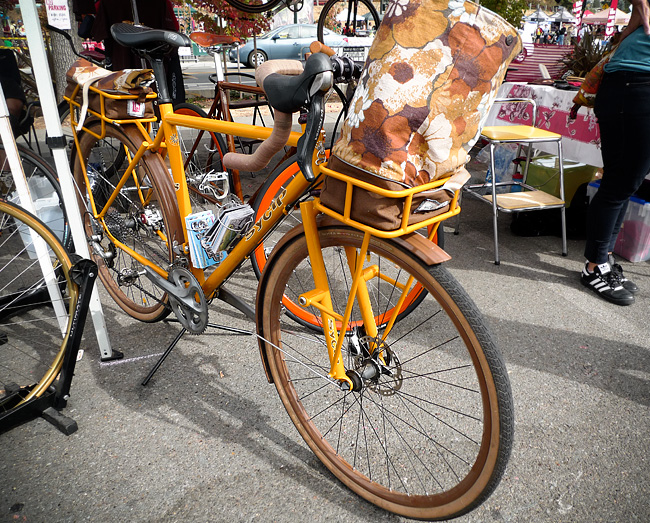 Sycip, a local Sonoma County builder.
Sycip, a local Sonoma County builder.
 Betty Foy‘s back-side (by Rivendell).
Betty Foy‘s back-side (by Rivendell).
 Bamboo-framed bikes including the Bamboosero.
Bamboo-framed bikes including the Bamboosero.
 LUCE goods = hand-made cycling clothes.
LUCE goods = hand-made cycling clothes.
One of several non-profits in attendance was the National Parks Conservancy. (I was staffing the WalkBikeMarin tent.)
Not pictured is the delicious Spanish paella I had for lunch courtesy of Venga Paella (Thanks Eduardo!) or the Lagunitas Brewing Co.’s PILS that I washed it down with. The PILS wasn’t bad, but it could not compare to my favorite pilsner brewed fresh in nearby Berkeley.
On the Road……The Warming Hut, San Francisco
These are vistas from near The Warming Hut — a touristy, but perfectly located place to stop for a snack (at either the picnic tables or at the cafe).
I didn’t try their coffee, so I cannot comment…Perhaps next time.
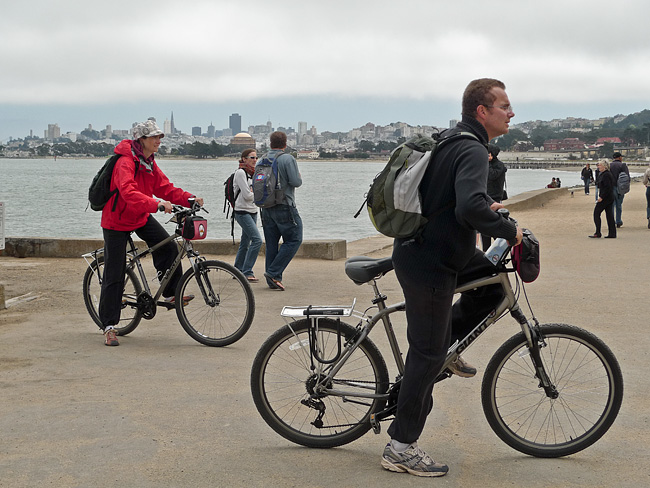 Beyond the bicycles, a little of the San Francisco skyline is visible (note the gold dome of the Palace of Fine Arts).
Beyond the bicycles, a little of the San Francisco skyline is visible (note the gold dome of the Palace of Fine Arts).
On the Road……A picnic table near Fort Point, San Francisco
Some photos made last month (looking northeast from a picnic table about half-way between the Bridge and Crissy Field).
On the Road……Olema’s Giant Eucalyptus Trees
The specimen below is probably the largest Eucalyptus I’ve seen. These trees are native to Australia and were originally planted in California — I’m guessing — as wind breaks for ranches and farms. They are quite draught resistant, making them extremely productive trees in this climatic zone. Plus, they smell really good!
On the Road……Highway 1 @ Vedanta Retreat, Olema
Just outside of Olema lies the Vedanta Retreat center.
I pedaled up the entry driveway past what they call the Vivekananda Bridge. There really was a palpable sense of peace and calm, maybe because for the last 37 years this has been a place “…where spiritual seekers of all faiths may meditate and study away from the disturbances of urban life.”
Here’s a synopsis of Vedanta philosophy from the Vedanta Society of Northern California‘s website:
The basic teaching of Vedanta is that the essence of all beings and all things–from the blade of grass to the Personal God–is Spirit, infinite and eternal, unchanging and indivisible. Vedanta emphasizes that man in his true nature is this divine Spirit, identical with the inmost being and reality of the universe. There is, in short, but one reality, one being, and, in the words of the Upanishads, “Thou art That.”
Vedanta declares that one can realize God in whatever aspect one wishes, and, further, that one can realize him directly and vividly in this life, in this world. Such realization constitutes spiritual freedom and contains in infinite measure the fulfillment of all man’s ideals and aspirations; it is indeed the true purpose of human life.
Vedanta holds that all religions lead to the same goal. Further, Vedanta reveres all great teachers and prophets, such as Sri Krishna, Lord Buddha, and Jesus Christ, and respects their teachings as the same eternal truth adapted to the needs of different times and peoples.
On the Road……Sir Francis Drake Blvd @ Highway 1
A typical Marin County bulletin board: “Holistic Lawyer”, “Way of the Goddess”, “Mystic Roots Band”, “Gurdjieff” and a plumbing contractor.
Sir Francis Drake Blvd. is eponymously named after the English explorer, pirate, slaver, and planet circumnavigator (Sir Francis Drake, b.1540-1596) and was once slated to become a four-lane highway known as CA Route 251:
…However, the development and freeway planning were stopped due to concerns about fragile ecosystems that urbanization would have damaged or destroyed….There was another problem though: the plan put the entire area on the San Andreas Fault. The decision to not redevelop West Marin made the freeway unnecessary, and it was therefore scrapped (from the Wikipedia entry)
Route Map……US Hwy 1: Heading South from Olema
One really appreciates elevation gains/losses when on a bicycle. To wit, I’ve traveled this stretch by automobile dozens of times and on all those occasions I perceived the route as being perfectly flat.
Anyhow, this stretch of Highway 1 connects the small west Marin towns of Olema and Bolinas. You travel over rolling hills and past park land and old ranches while following the San Andreas earthquake fault along the valley floor. (I wrote a little about this natural history and geology in an earlier post).
On the Road……Olema, End of Indian Summer
I discovered a new swimming hole this year. Just in time, as Northern California’s Indian Summer (usually Sept-Oct) finally ushered in some genuinely hot weather.
Last year’s End of Summer post described another popular swim hole: the Inkwells.
The new spot is about a 15-mile roundtrip from the town of Olema, with mostly rolling hills and the occasional volley of cars skimming by pretty close as there is no shoulder for protection along Hwy 1.
On the Road……In front of the Minnesota Zen Center
I made this picture and only later discovered I had stopped right in front of the Minnesota Zen Center.
Too bad my visit was so short. I could have sat zazen and listened to a dharma talk by the center’s teacher — an early student of Suzuki Roshi (founder of the San Francisco Zen Center).
Click here for a rare video of Suzuki Roshi.
On the Road……Shoreline flora along Lake Calhoun, Minneapolis
Espresso Review……Dunn Bros. Coffee + 5 Dimensions of Espresso
In Minneapolis, I visited Cafe Imports — a green coffee trading company — and was thrilled to have the opportunity to participate in a cupping of Brazilian, Peruvian, Indonesian, and Nicaraguan coffees. I also sampled a complex Kenyan auction lot coffee brewed both in a Hario pour-over and in a Clover.
Later, while out riding in the rain, I visited the Dunn Bros. Coffee shop that adjoins Calhoun Cycle, which I wrote about here.
At Dunn Bros., the ambiance was cozy and bright — a perfect spot to enjoy a coffee. The espresso was okay. I probably should have ordered a latte or something because they don’t do a true espresso.
So what is a true espresso? Read the rest of this entry »
On the Road……Grand Rounds Scenic Byway, Minneapolis
Minneapolis shares something with my beloved Marin County.
Each is one of the four select communities chosen to be part of the NTPP (Non-motorized Transportation Pilot Project), a $100 million federal program to test how infrastructure improvements can increase rates of bicycling and walking.
I was in Minneapolis just briefly, but I still picked up a strong bicycle culture (Bicycling Magazine named it the most bike-friendly city in the country).
I circled Lake Calhoun (part of the 50-mile Grand Rounds Scenic Byway) and explored adjacent neighborhoods.
I was a bit confused, however, by some of the signage and rules. The bike path circling the Lake is one-way (note the picture above)!
This is great for recreational use, but for transportation purposes it makes it less useful as a bike boulevard or arterial.
On the Road……Rainstorm over Lake Calhoun, Minneapolis
I had hoped to spend a day and a half exploring Minneapolis by bike. But the severe weather (some areas of Minnesota received 10″ of rain over the two-day period) partially quashed those plans.
Nonetheless, I overcame my inertia (and lack of full rain gear) to still manage some wet weather explorations on the new Brompton.
On the Road……Uptown, Minneapolis and Calhoun Cycle
My Brompton was inspected by TSA baggage handlers (they left their dreaded, yet polite calling card).
Whether it was the result of a poor re-packing job by TSA Screener #101906 I cannot say, but the spokes and fender stays of the front wheel emerged a little unhappy after the 3.5 hour San Francisco-to-Minneapolis flight.
My friend in Minneapolis just happens to lives about 2 miles away from Calhoun Cycle, a local Brompton dealer. I rode over in a pouring rainstorm and Kody (pictured above) trued the wheel and straightened the bent fender stay.
The cost: $5!
The place exudes a pleasant alternative transportation, indie bike shop vibe. Plus, it’s connected through a common wall opening to a Dunn Brothers Coffee house (kind of a mid-western Peet’s, but with on-site roasting).
Here’s Calhoun Cycle’s philosophy (from their website):
We think spinning on a bike is a great way to physical, emotional and spiritual fitness. Reducing pollution, road congestion and parking stress are icing on the cake. The bicycles and accessories we sell are designed to help you be successful cyclists, whether you’re touring Nepal or bopping around the corner for milk.
Gear Gallery……Ladies and Gentleman, the Brompton
I vowed my next bike would be a folding bike. A planned short trip to Minneapolis proved to be the trigger.
I narrowed it down and compared two very different bikes: The Dahon Mu Uno and a 3-speed Brompton M type.
I plan to have more notes and photos on the comparison and which one I ultimately chose and why. (Although these images of the Brompton packed for airline travel are a giveaway.)
On the Road……Bon Tempe Lake & Reservoir
A quick bike ride up the mountain to Bon Tempe Lake to recalibrate mind/body.
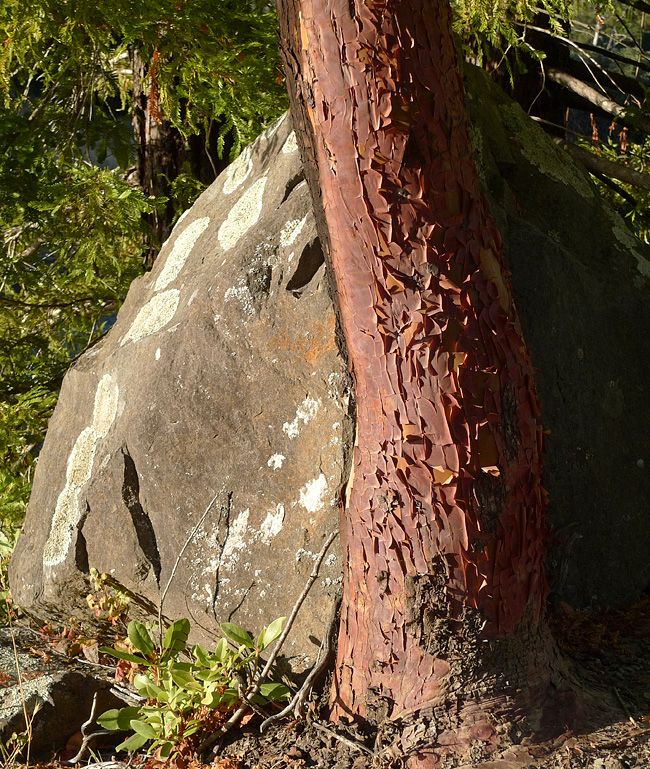 A native Madrone (Arbutus menziesii) — one of my favorite trees with its curious exfoliating bark.
A native Madrone (Arbutus menziesii) — one of my favorite trees with its curious exfoliating bark.
On the Road……SF’s Golden Gate Bridge, Westside, North Tower
On the Road……SF’s Golden Gate Bridge
On the Road……Guerciotti on the Golden Gate Bridge
I recently did some exploring around the Golden Gate Bridge (and down by The Warming Hut).
This view is from the western side of the bridge looking toward the south-west. I believe the Seacliff/Richmond neighborhood is visible in the background.
Random Images……Praying Mantis on the Back Patio
I found this beautiful, nearly 6 inch long, praying mantis in a container plant on my back patio.
Since reading Laurens van der Post’s A Mantis Carol, and learning the Bushmen of the Kalahari regard them as manifestations of God, I always approach these creatures with a special reverence. In the Islamic world, they are also important religious symbols. Plus, their subtle movements evoke meditation and mindfulness.
I like to think this little creature’s visit was a reminder to have more subtle awareness of my life and to not get too caught up in the day’s chaos.
What does this have to do with bicycling?
Well…for me riding a bike is good mindfulness practice: It helps me to regain peace of mind after a hard day and helps me to observe my everyday world with a somewhat greater sense of clarity.
Bicycling Culture……City Bike Sharing Schemes
Is European-style bike sharing coming to the Bay Area?
Maybe so.
The BAAQMD has requested $5.14 million from MTC to fund a bike share pilot project.
The company I’ve been working with Alta Planning + Design has spun-off a new company (Alta Bike Share) that helps cities design and operate these systems. Together with Bixi, we installed an on-street demo for a bike-savvy San Francisco audience at last week’s Sunday Streets.
The Bixi bicycle kiosk system — including the bicycle models used by the Melbourne, London, and Montreal bike sharing operations — was on display.
Bicycling Culture……San Francisco’s Sunday Streets
This bike share demo was my first experience with San Francisco’s Sunday Streets. (Whereby I also discovered — and highly recommend — the mobile food cart, Chairman Bao.)
Closing down streets to auto traffic began with Bogota’s Ciclovia. Here’s some of the history from SF Sunday Street’s website:
Ciclovía, literally “bike path” in Spanish, is a ground-breaking event that started in Bogotá, Colombia. This weekly event draws more than 1.5 million people to walk, bike, skate and enjoy more than 70 miles of streets opened to people – and closed to automobile traffic – every week.
Nearly 20% of this city’s population turns out every Sunday and holiday to participate in the 7 am to 2 pm event, which includes unparalleled free recreation and social opportunities, including dance and yoga lessons in the city’s streets and local parks.
“A quality city is not one that has great roads but one where a child can safely go anywhere on a bicycle.” Enrique Peñalosa, Former Mayor of Bogotá, Colombia.
 John (navy-blue uniform and shades) is the Bixi installation wizard from Montreal. Brodie (light green shirt on the right) manages operations for Alta Bike Share. Sylvia (cap and light green shirt) was, like me, helping out for the day with public information and outreach.
John (navy-blue uniform and shades) is the Bixi installation wizard from Montreal. Brodie (light green shirt on the right) manages operations for Alta Bike Share. Sylvia (cap and light green shirt) was, like me, helping out for the day with public information and outreach.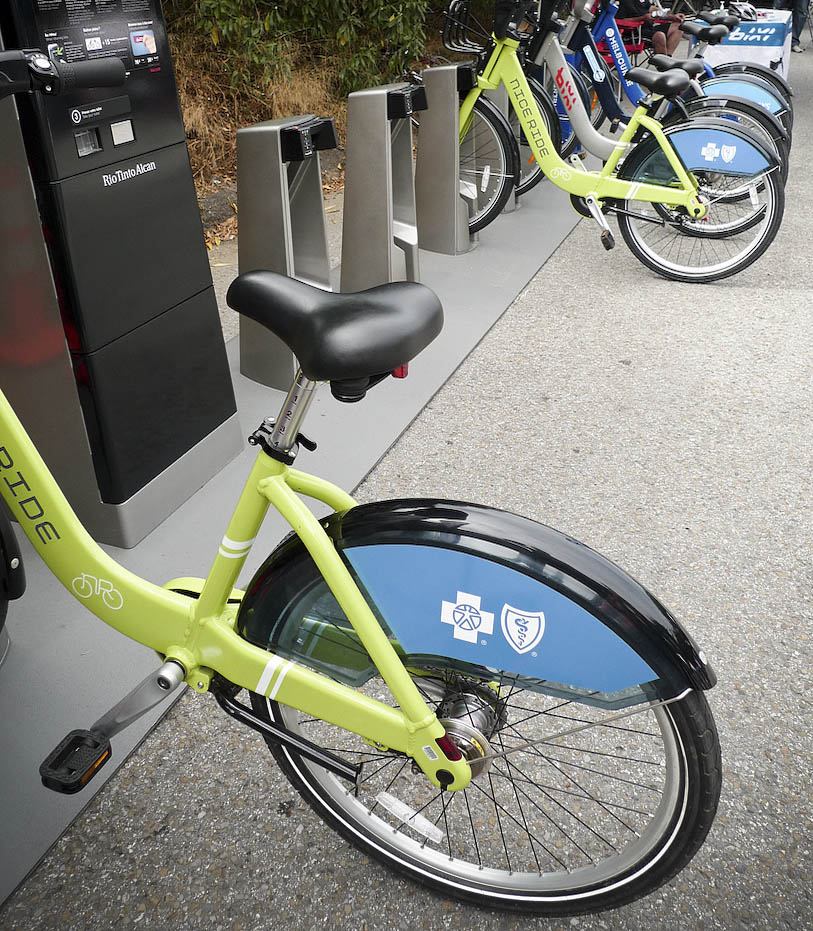
The bikes themselves have lots of useful features: built-in generator hubs to power front and rear lights; internal frame-routed cables; height adjustable seats (yet non-removeable, and thus theft-proof); chain and skirt guards; three-speed internal gear-hubs; and, a front basket-like purse/brief case carrier with bungee cord.
On the Road……China Camp State Park, San Rafael
China Camp State Park borders the San Pablo Bay. Less well-known than the San Francisco Bay, San Pablo Bay has its own low-key charm.
The lagoons and picnic areas around China Camp are great places to stop for a beer, some food, or just to soak your feet (if not go for a swim). Plus, the trails in the surrounding hills draw mountain bikers from around the region.
The name of the park derives from the 1880s Chinese shrimp fishing village that once thrived here.
Note: right pant leg tucked carefully into sock.
On the Road……N. San Pedro Rd, heading to China Camp State Park
On the Road……Bicycling, Carbon Footprints, and a Sense of Wonder
I recently pedaled up to Alpine Lake and had the foresight to pack a little fruit and one of these spiffy stainless steel Japanese Suncraft knives.
As I bit into this juicy kiwi, I remember thinking:
How is it that I’m sitting here now and eating a tiny fruit that was harvested on the other side of the earth?
There was no judgment over the astronomical (one might even say grotesque) carbon footprint of my organic New Zealand kiwi – it was simply a sense of wonder that I live at a time in human history where such an act is even possible.
Note: After writing the above post I discovered that a “sense of wonder” is a recognized concept in science fiction literature. It’s related to a “numinous” experience. Here’s an excerpt from the Wikipedia entry:
The sense of wonder is related to, but not identical to, the concept of the numinous…the numinous, in this case, is the understanding that there is something not directly comprehensible, but large and entirely other, in the world. The sense of wonder, by contrast, is the understanding that there is something that one had not fully comprehended — or perhaps had not even recognized that there was something to be comprehended — until that point.
Bicycling Culture……The Bike Blog Universe
The Velo Hobo (aka Jack from North Carolina) was kind enough to spotlight me in one of his recent “featured rider” posts.
Initially, I told him I was a little embarrassed by the distinction. The cycling community is full of so many riders that are accomplishing amazing physical feats or doing other extraordinary things with bicycles. I felt a little inadequate in this regard. But I’ll continue to do my part, whatever that may be. Thanks Jack!
And this reminds me. I’ve been remiss in acknowledging other blogging friends and supporters of The Friday Cyclotouriste to whom I am most grateful. They include:
- Myles at Rat Trap Press;
- Eddie at The Everyday Cyclist;
- Esteban at velo-flaneur;
- Alan and Michael at EcoVelo;
- Meli at Bikes and the City; and,
- Dave at Yurtville.
All are amazing blogs. I encourage you to visit.
(P.S. The above picture, which I sent to Jack, was made with the camera on the ground using the 10-second timer on a recent Thursday evening ride up the hill near Alpine Lake).

 Show on map
Show on map